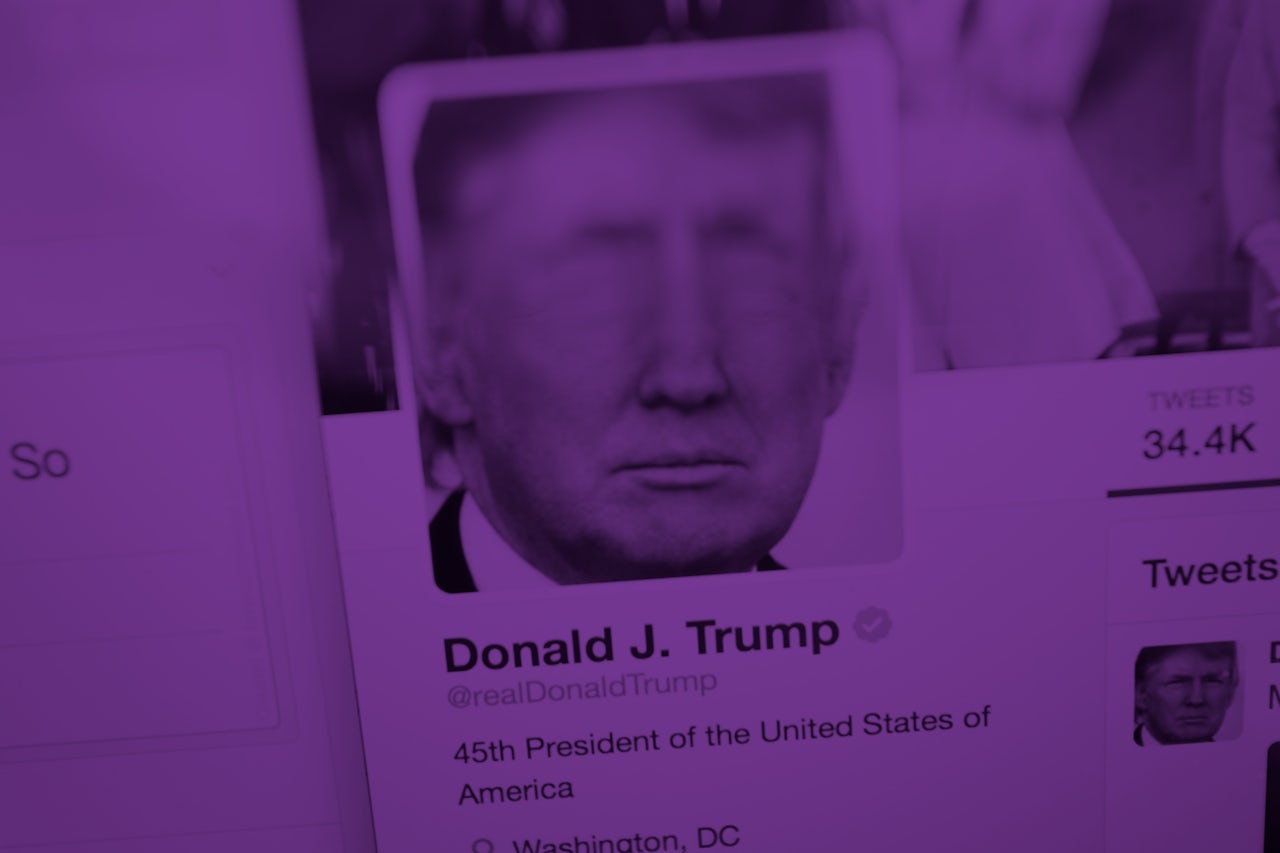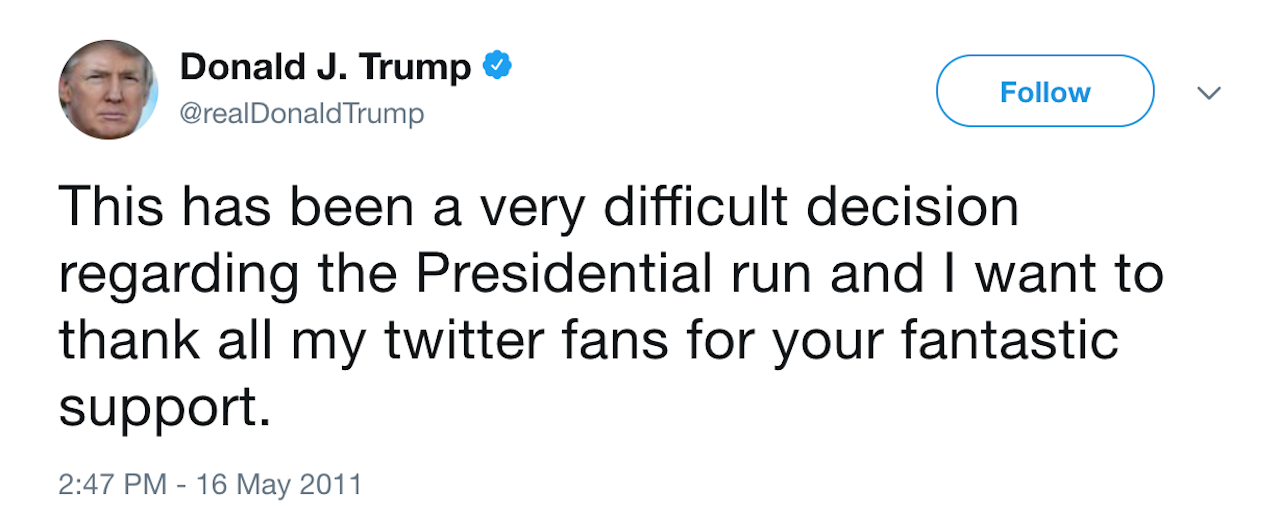It is almost impossible to remember a time before Donald Trump and @realDonaldTrump were one and the same. Like a knight and his sword, a cowboy and his horse, it now feels as if the tool has become an appendage of the man himself, offering a direct line of sight into his distorted and deeply troubling inner world.
But this love affair had to start somewhere, and after delving deep into the archives, it seems its origin can be traced not just to a single time period, but in fact a single day, and a single tweet.
Let’s start at the beginning.
The future Twitterer-In-Chief joined the platform in March 2009. He tweeted for the first time on May 4, 2009 at 2:54 PM.
This initial dispatch is characteristic of almost all of his subsequent tweets for the next two years, and was typical of how many public figures interfaced with the platform in its early days (Twitter was founded in 2006). It was purely a promotional tool for spouting out information, mostly devoid of any meaningful opinion or personality, like a carnival barker screaming periodic status updates into the void. Trump’s account was clearly controlled by his “team,” and at times, would clarify that a particular message was “From Donald Trump.” Tweets were about The Apprentice, Trump properties, and other miscellaneous business ventures.
Concurrently, outside the Twitterverse, Trump was quite outspoken about politics. By March 2011, he was proudly endorsing birtherism on Fox News and elsewhere. Nevertheless, this fervor never permeated into his Twitter feed. Instead, his 300,000-some followers would see this:
Even as he became more politically active IRL, and even elsewhere online in the form of vlogs titled “From the Desk of Donald Trump” denouncing the Obama administration (also complimenting Derek Jeter and reviewing The Dark Knight Rises), no substantive opinions made their way onto Twitter. In his mind and in the mind of those around him, Twitter was never the main event, only an amplifier of something said or done elsewhere.
Sure, there were a few outliers. There were five rogue tweets in early 2011 in which Trump expressed his support for the prescient, fan-created website called ShouldTrumpRun.com — technically still self-promotional, but a little sloppier and more visceral in their execution. The most significant departure from the norm was on May 16, 2011, 17 days after President Obama and Seth Meyers’ infamous roasting of Trump at the 2011 White House Correspondents’ Dinner, which many suspect of having played a role in Trump’s decision to pursue the presidency.
This tweet sits squarely between tweets about Trump's Fabulous World of Golf and the next Miss USA, so while it may have been the earliest seed of Trump’s Twitter awakening, it had yet to blossom. In Team Trump’s world, Twitter played a role, but not a “news breaking” role. It broadcasts the story, but it never is the story.
So, when did the shift occur? When did Trump and his Twitter feed first align and become the dynamic duo we now know so well? It was Wednesday, July 6, 2011, at 10:38 AM.
There it is.
It’s all too familiar to us now. The alarmist tone, the arbitrary capitalization, the authoritative “hot take” on a complex issue squeezed awkwardly into 140 characters. This is the @realDonaldTrump of today, and it was born on July 6, 2011, at 10:38 AM.
The difference before and after is stark. A majority of Trump’s tweets over the following few months are overtly political, criticizing then President Obama — who went virtually unmentioned on his feed until this day — criticizing Republicans, and particularly ripping into John Boehner, then the Republican Speaker of the House. Here we also finally see those frantic typos we’ve become so accustomed to, something that would rarely happen when Trump’s marketing braintrust was apparently calling the shots. His number of followers steadily grew ever since, surpassing 40 million earlier this month.
So, what changed? What caused this seismic transformation?
The truth is, we may never know. Perhaps someone at the Trump organization simply put the app on his phone. But let’s assume for a moment that it was something else, something that was happening outside of his bubble, something in the public eye that his inner circle couldn’t shield him from. So, what was happening around July 6, 2011?
Perhaps @realdonaldtrump was awakened by the hack of Fox News’ Twitter account that occurred on July 4. It was covered on Fox News, and could have piqued Trump’s interest in the platform.
But there is a more compelling possibility. On the exact day in question, July 6, 2011, at 2 PM EST, the Obama administration held the world’s first ever “presidential Twitter Town Hall.”
Hosted by Jack Dorsey, co-founder and CEO of Twitter, this event had all the trappings of the “first” of something very experimental and new. Dorsey kicks it off by reading a stiff introduction off notecards like it’s a middle school book report. At one point, Obama stands silently at a laptop for a little too long, ready to become, in his words, “the first president to live tweet.” Yikes.
But then, as the President begins to answer people’s tweeted questions, it becomes clear that that this is truly unprecedented. For the first time, the White House is characterizing this platform as important enough to lead a national conversation, powerful enough to actually reach out and communicate directly with the President of the United States. In fact, at this time, the Obama administration was making a concerted effort to take social media more seriously. They held similar town halls on YouTube and Facebook earlier in the year, and the President had sent out his first-ever personal tweet from the POTUS Twitter account only two weeks earlier, signing it “- BO.” All in all, in 2011, the Obama administration, and Obama himself, were actively trying to transition the Presidency into the 21st century, and Twitter was a cornerstone of this effort.
Twitter was never the main event, only an amplifier of something said or done elsewhere.
This town hall received significant press coverage in the week leading up to it, with questioners being asked to use the hashtag #AskObama to “get their questions to the president.” Dan Pfeiffer, currently a CNN contributor and co-host of the popular political podcast Pod Save America, was Obama’s Communication Director at the time, and was being widely cited as a major architect of this modernization. “We’ve entered a different information age, where people get news and information in a different way than they did in the past,” he said on a conference call with reporters on July 5. “If you’re going to communicate with the broad public, it is no longer sufficient to simply do it through traditional mainstream media.”
Could this event, and the press surrounding it, have been the catalyst for Trump’s Twitter awakening? After all, multiple influential conservatives took to Twitter on the morning of the 6th to add their voices to the influx of questions and concerns being thrown at the President, including blogger Jim Geraghty, Speaker John Boehner, and presidential hopeful Mitt Romney — Boehner’s tweet preceded Trump’s by only a few minutes. As an avid watcher of cable news, undoubtedly Trump was inundated with coverage promoting the upcoming event and asking people to take to Twitter to join the conversation. In other words, anchors and television personalities that Trump trusted and believed in were looking him dead in the eye and telling him, “If you tweet, people will listen. And not just anybody... powerful people, people who you want to be heard by.”
And so, on the morning of the first ever Twitter town hall, Donald Trump tightened the belt on his best terrycloth bathrobe, reached for his smartphone, and tweeted a raw, unfiltered political critique, aimed at Obama, in order to enter that conversation and take ownership of his presence on the platform. Thus began the age we are in now, in which Trump uses Twitter to attack, to defame, to set policy, and to alter the course of history. This era began on July 6, 2011, the day Jack Dorsey read off of notecards in the East Room of the White House, describing Twitter users as “everyday people engaging in spirited debate about the future of their countries.”






